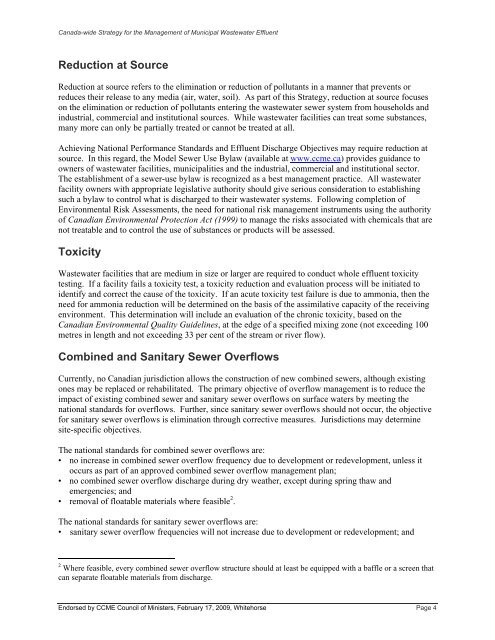Canada-wide Strategy for the Management of Municipal ... - CCME
Canada-wide Strategy for the Management of Municipal ... - CCME
Canada-wide Strategy for the Management of Municipal ... - CCME
Create successful ePaper yourself
Turn your PDF publications into a flip-book with our unique Google optimized e-Paper software.
<strong>Canada</strong>-<strong>wide</strong> <strong>Strategy</strong> <strong>for</strong> <strong>the</strong> <strong>Management</strong> <strong>of</strong> <strong>Municipal</strong> Wastewater Effluent<br />
Reduction at Source<br />
Reduction at source refers to <strong>the</strong> elimination or reduction <strong>of</strong> pollutants in a manner that prevents or<br />
reduces <strong>the</strong>ir release to any media (air, water, soil). As part <strong>of</strong> this <strong>Strategy</strong>, reduction at source focuses<br />
on <strong>the</strong> elimination or reduction <strong>of</strong> pollutants entering <strong>the</strong> wastewater sewer system from households and<br />
industrial, commercial and institutional sources. While wastewater facilities can treat some substances,<br />
many more can only be partially treated or cannot be treated at all.<br />
Achieving National Per<strong>for</strong>mance Standards and Effluent Discharge Objectives may require reduction at<br />
source. In this regard, <strong>the</strong> Model Sewer Use Bylaw (available at www.ccme.ca) provides guidance to<br />
owners <strong>of</strong> wastewater facilities, municipalities and <strong>the</strong> industrial, commercial and institutional sector.<br />
The establishment <strong>of</strong> a sewer-use bylaw is recognized as a best management practice. All wastewater<br />
facility owners with appropriate legislative authority should give serious consideration to establishing<br />
such a bylaw to control what is discharged to <strong>the</strong>ir wastewater systems. Following completion <strong>of</strong><br />
Environmental Risk Assessments, <strong>the</strong> need <strong>for</strong> national risk management instruments using <strong>the</strong> authority<br />
<strong>of</strong> Canadian Environmental Protection Act (1999) to manage <strong>the</strong> risks associated with chemicals that are<br />
not treatable and to control <strong>the</strong> use <strong>of</strong> substances or products will be assessed.<br />
Toxicity<br />
Wastewater facilities that are medium in size or larger are required to conduct whole effluent toxicity<br />
testing. If a facility fails a toxicity test, a toxicity reduction and evaluation process will be initiated to<br />
identify and correct <strong>the</strong> cause <strong>of</strong> <strong>the</strong> toxicity. If an acute toxicity test failure is due to ammonia, <strong>the</strong>n <strong>the</strong><br />
need <strong>for</strong> ammonia reduction will be determined on <strong>the</strong> basis <strong>of</strong> <strong>the</strong> assimilative capacity <strong>of</strong> <strong>the</strong> receiving<br />
environment. This determination will include an evaluation <strong>of</strong> <strong>the</strong> chronic toxicity, based on <strong>the</strong><br />
Canadian Environmental Quality Guidelines, at <strong>the</strong> edge <strong>of</strong> a specified mixing zone (not exceeding 100<br />
metres in length and not exceeding 33 per cent <strong>of</strong> <strong>the</strong> stream or river flow).<br />
Combined and Sanitary Sewer Overflows<br />
Currently, no Canadian jurisdiction allows <strong>the</strong> construction <strong>of</strong> new combined sewers, although existing<br />
ones may be replaced or rehabilitated. The primary objective <strong>of</strong> overflow management is to reduce <strong>the</strong><br />
impact <strong>of</strong> existing combined sewer and sanitary sewer overflows on surface waters by meeting <strong>the</strong><br />
national standards <strong>for</strong> overflows. Fur<strong>the</strong>r, since sanitary sewer overflows should not occur, <strong>the</strong> objective<br />
<strong>for</strong> sanitary sewer overflows is elimination through corrective measures. Jurisdictions may determine<br />
site-specific objectives.<br />
The national standards <strong>for</strong> combined sewer overflows are:<br />
• no increase in combined sewer overflow frequency due to development or redevelopment, unless it<br />
occurs as part <strong>of</strong> an approved combined sewer overflow management plan;<br />
• no combined sewer overflow discharge during dry wea<strong>the</strong>r, except during spring thaw and<br />
emergencies; and<br />
• removal <strong>of</strong> floatable materials where feasible 2 .<br />
The national standards <strong>for</strong> sanitary sewer overflows are:<br />
• sanitary sewer overflow frequencies will not increase due to development or redevelopment; and<br />
2 Where feasible, every combined sewer overflow structure should at least be equipped with a baffle or a screen that<br />
can separate floatable materials from discharge.<br />
Endorsed by <strong>CCME</strong> Council <strong>of</strong> Ministers, February 17, 2009, Whitehorse Page 4
















